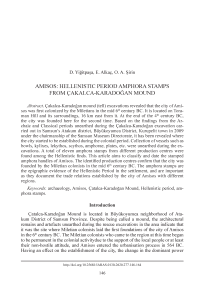Amisos: Hellenistic Period Amphora Stamps from Qakalca-Karadogan Mound
Автор: Yiitpaa D., Alka E., Irin O.A.
Журнал: Краткие сообщения Института археологии @ksia-iaran
Рубрика: Железный век и античность
Статья в выпуске: 277, 2024 года.
Бесплатный доступ
Qakalca-Karadogan mound (tell) excavations revealed that the city of Amisos was first colonized by the Miletians in the mid 6th century BC. It is located on Toraman Hill and its surroundings, 16 km east from it. At the end of the 4th century BC, the city was founded here for the second time. Based on the findings from the Archaic and Classical periods unearthed during the Qakalca-Karadogan excavation carried out in Samsun's Atakum district, Buyukoyumca District, Kurupelit town in 2009 under the chairmanship of the Samsun Museum Directorate, it has been revealed where the city started to be established during the colonial period. Collection of vessels such as bowls, kylixes, lekythos, scythos, amphorae, plates, etc. were unearthed during the excavations. A total of eleven amphora stamps from different production centres were found among the Hellenistic finds. This article aims to classify and date the stamped amphora handles of Amisos. The identified production centres confirm that the city was founded by the Miletian colonists in the mid 6th century BC. The amphora stamps are the epigraphic evidence of the Hellenistic Period in the settlement, and are important as they document the trade relations established by the city of Amisos with different regions.
Archaeology, amisos, qatalca-karadogan mound, hellenistic period, amphora stamps
Короткий адрес: https://sciup.org/143184158
IDR: 143184158 | DOI: 10.25681/IARAS.0130-2620.277.146-164
Текст научной статьи Amisos: Hellenistic Period Amphora Stamps from Qakalca-Karadogan Mound
Çatalca-Karadoğan Mound is located in Büyükoyumca neighborhood of Ata-kum District of Samsun Province. Despite being called a mound, the architectural remains and artefacts unearthed during the rescue excavations in the area indicate that it was the site where Miletian colonists laid the first foundations of the city of Amisos in the 6th century BC. The Miletian colonists who came to the region at this time began to be permanent in the colonial activitydue to the support of the local people or at least their non-hostile attitude, and Amisos entered the urbanisation process in 564 BC. Having an effect on the establishment of the city, the change in the dominant power
structure in the region in 546 BC also contributed to the expansion of the borders ( Şirin , 2023. P. 93–96).
While life continued in the area where the first foundations of the city were laid, Athenian colonists from Sinope settled in the city’s territory in 437 BC. The second wave of colonists settled in and around Toraman Tepe, which is located in today’s İlkadım District, 9 km west of the area where the first colonists settled (Çakalca-Ka-radoğan Mound). Archaeological data in the region reveal that Amisos was in contact with the Athenian colonists. In the late 4th century BC, the political, social and economic life of the city of Amisos strengthened in this second location with the influence of the Mithradates Kingdom, and the second foundations of the city began to appear here. The settlement at Çakalca-Karadoğan Mound continued throughout the Hellenistic Period, and while the trade activities in the region declined, this trade volume found a place in the new locality (Toraman Tepe and its surroundings). The territory of the city expanded, which continued during the Roman Imperial Period, and the city maintained its important position until the Byzantine Period (Ibid. P. 95–98).
The rescue excavations conducted by the Directorate of Samsun Museum, where the stamped amphora handles were recovered, were carried out in 12 trenches. The trenches were designated by dividing an area measuring 20 × 93 m into 10 sq. m grids. The reference point for the surface level of the excavation area is +12,260 m. The archaeological data of the excavation area show that the mound functioned continually throughout the historical period from the Archaic Period to the later Hellenistic Period. Finds from the settlement were dated to the Archaic, Classical and, albeit with a decrease, Hellenistic periods (Fig. 1) ( Şirin , 2020. P. 514, 515)1.
A total of eleven amphora stamps from different production centres were found among the Hellenistic finds. This article aims to classify and date the stamped amphora handles of Amisos, whose foundations were laid by Miletian colonists in the mid 6th century BC, according to their production centres. These amphora stamps, which are the epigraphic evidence of the Hellenistic Period in the settlement, are important as they evidence the trade relations established by the city of Amisos with different regions (tabl. 1, see at the end of the article).
Sinope Stamps
No. 1 (Fig. 2: 1 ) . It was unearthed in the area called botros , in trench no. III, at the junction of plan squares A3 and A4. The fixed point code for the surface level of the excavation area was determined as +12.260 m, and the leveling work in the area where the handle exits ended at +9.066 m. The handle piece was exposed within these levels, at the +9.510 m code level. As we descended from the +9.510 m code level, imported black and red-figure ceramic fragments produced in Attica, Cybele sitting on the throne and Kore figurines, which were used as a votive offering to the goddess Cybele, were discovered.
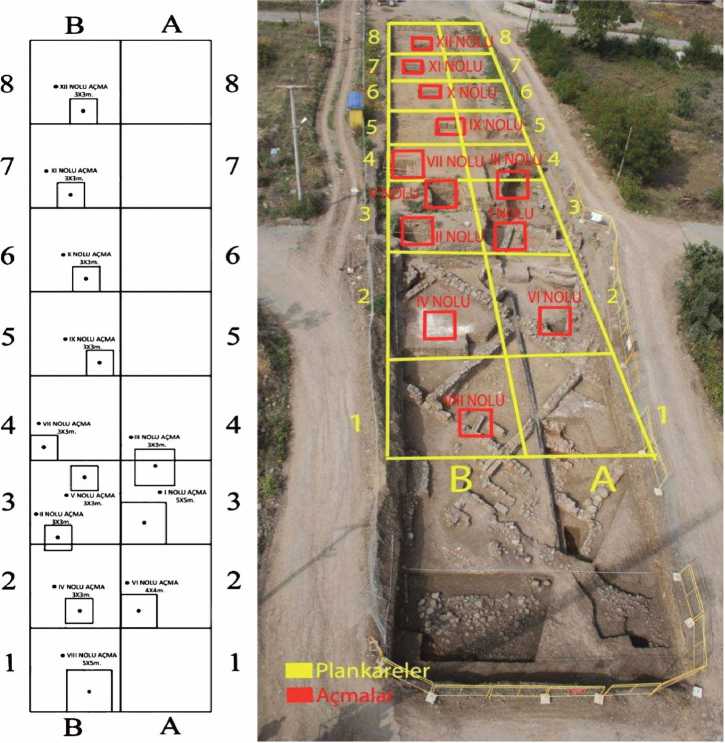
Fig. 1. Find locations of stamped amphora handles from the Amisos city excavations
Rectangular, 6.0 × 2.8 cm, normal, four horizontal inscription lines. Eponym: Αἰσχρίων Ἀρτεμιδώρου. Fabricant: Ὀνήσιμος. Date: c. 257 – c. 190 BC.
Ἀσ[τυνόμου]
Αἰ[σχρίωνος] [device ?] τοῦ [Ἀρτεμιδώρου]
Ὀνή[σιμος]
The stamp bears the names of the eponym Αἰσχρίων Ἀρτεμιδώρου and the fabricant Ὀνήσιμος. On the right side of the stamp is an unidentified symbol. This eponym is associated with the producers Ἀγάθων, Ἡρακλέων and Καλλισθένης. The stamps with the name of the eponym bear the symbols of a kantharos, a head, a bunch of grapes and a club (Garlan, 2004. P. 233, 234. No. 541–545. Pl. LXI). N. Conovici dates this eponym’s period of office as Period V (c. 257 – c. 190 BC) (Conovici, 1998. P. 49). The fabricant Ὀνήσιμος has also been related to Ναύπων III Δίου, eponym of Period VIE (Garlan, 2004. P. 246. No. 595. Pl. LXVII). This stamp is identical to the example found in Sinope (Ibid. P. 234. No. 545. Pl. LXI).
No. 2 (Fig. 2: 2 ) . This stamp was recovered from the section called Room C of the 3-roomed area that emerged when Trenches IV, VI and VIII were merged in Grid A1. The fixed point for the surface level of the excavation area is +12.260 m. The level descent in the area where the handle was recovered ended at +9.180 m. The handle fragment was unearthed between these levels together with the remains of the area in question. Finds such as stroter, calypter, fragments of kitchen vessels, bronze nails, traces of plaster, unstamped amphora handles, and bronze coins belonging to the Mithradates VI Period were recovered from the area where the handle was found.
Rectangular, 6.1 × 2.9 cm, normal, four horizontal inscription lines. Eponym: Ἀπολλωνίδης Ποσειδωνίου. Fabricant: Φιλήμων. Date: c. 257 – c. 190 BC.
Ἀστυνομοῦντος
Ἀπολλωνίδου τοῦ grape
Ποσειδωνίου cluster
[Φ]ιλήμων
The stamp bears the names of the eponym Ἀπολλωνίδης Ποσειδωνίου and fabricant Φιλήμων. A bunch of grapes and a torch are placed on the right side of the inscription. Conovici dates this eponym’s period of office as Period V (c. 257 – c. 190 BC). The eponym is known to be associated with the fabricants Μάνικκος, Ἀγάθων, Θέων, Ἐπιχαρής, Διονύσιος, Ἀρτέμων, Μῆνις, Δας, Εὐκλῆς, Πολύχαρμος and Στέφανος (Ibid. P. 235, 236. No. 549–551; Conovici, 1998. P. 150. No. 571–573; , Sinope: Ἀπολλωνίδης Ἀπολλωνίδου). The fabricant was active under the magistracy of the eponym Μητρόδωρος II Ἀθη-νίππου. This stamp from the Çatalca-Karadoğan Mound is identical to the examples from Satu Nou (Conovici, Irima, 1991. P. 157. No. 211, 212. Fig. 11) and Krutoi Bereg , Sinope: Ἀπολλωνίδης Ἀπολλωνί-δου – Φιλήμων).
No. 3 (Fig. 2: 3 ) was recovered from Trench I in Grid A3. The fixed point for the surface level of the excavation area is +12.260 m. The level descent in the area where the handle was recovered ended at +9.316 m. The handle fragment was recovered in between these levels up to +9.466 m. Below this level, fragments of imported Attic pottery with black glaze were recovered. The foundation remains unearthed in the trench were evaluated as the remains of a two-phase structure, and the handle fragment was related to the late phase.
Rectangular, ? × 3.0 cm, normal, three horizontal inscription lines. Eponym: Καλλισθένης I. Fabricant: Βάχιος II. Date: c. 257 – c. 190 BC.
Βάχιος
Ἀσ[τυνόμου] Arrow in quiver [Καλλισθένου]
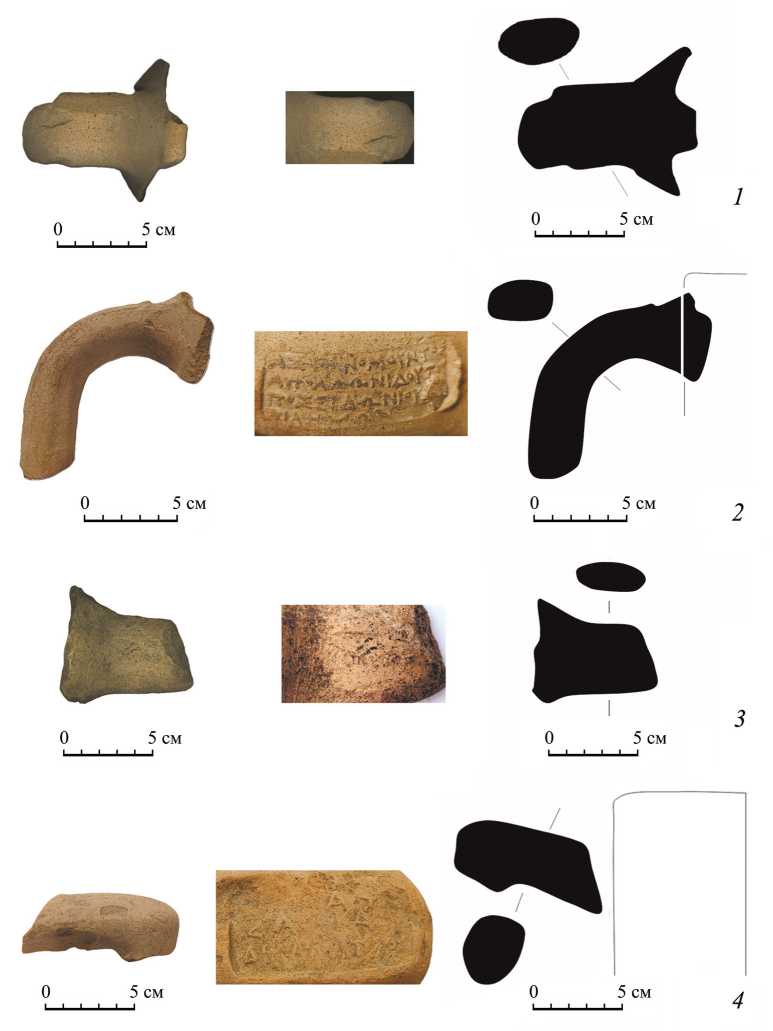
Fig. 2. Amisos. The stamped amphora handles 1–3 – Sinope center; 4 – Rhodos center
The stamp bears the names of the eponym Καλλισθένης I and the fabricant Βάχιος II. The upper right part of the stamp bears the symbol of an arrow in a quiver. The eponym Καλλισθένης I is stated to have served in Period V (c. 257 – c. 190 BC) ( Garlan , 2004. P. 97). This stamp originates from the same mould as the stamps found at Kallatis ( Buzoianu, Cheluta-Georgescu , 1983. P. 176. No. 68) and Sinope ( Gar-lan , 2004. P. 169. No. 265. Pl. XXXII). The eponym’s relations with the fabricants Κλέων, Κτησικλῆς, Μιθραδάτης, Πρῶτος, Πύθῆς, Στέφανος and Τιμοκράτης II have been identified ( Conovici , 1998. P. 81, 82. No. 135–147). The fabricant was found to be related to eponyms Διονύσιος III and Διονύσιος IV ( Garlan , 2004. P. 166, 168. No. 253, 260).
Rhodian Stamps
No. 4 (Fig. 2: 4 ) . This stamp was recovered from the section called Room C of the 3-roomed area that emerged when Trenches IV, VI and VIII were merged in Grid A1. The fixed point for the surface level of the excavation area is +12.260 m. The level descent in the area where the handle was recovered ended at +9.180 m. The handle fragment was unearthed between these levels together with the remains of the area in question. Finds such as stroter, calypter, fragments of kitchen vessels, bronze nails, traces of plaster, unstamped amphora handles, and bronze coins belonging to the Mithradates VI Period were recovered from the area where the handle was found.
Rectangular, 4,4 × 1,8 cm, normal, three horizontal inscription lines. Eponym: Παυσανίας III. Month: Ἀρταμίτιος. Date: c. 152 BC. Matrix: RE-ΠΑΥΣΑΝΙΑΣ 03-ΑΡΤΑΜΙΤΙΟΣ-007.
[Ἐπὶ Π]αυ-σα[ν]ία Ἀ[ρτ]αμιτίου
The stamp reads the name of the eponym Παυσανίας III with the month Ἀρταμίτιος. Their magistracy is dated to c. 152 BC in Period IVb ( Finkielsztejn , 2001. P. 193. Tab. 20). Some of his stamps bear motifs such as the head of a ram ( Cankar-deş-Şenol , 2016. P. 216, RE-ΠΑΥΣΑΝΙΑΣ 03-ΔΑΛΙΟΣ-012), rose ( Jöhrens , 1999a. P. 80. No. 210) or Helios head ( Finkielsztejn , 2001. Pl. VIII: no. 154 ). The fabricants Ἀριστοκλῆς II, Ἐπικράτης II, Ἡφαιστίων, Θεύμναστος, Ἰέρων, Ἴμας, Ἱπποκράτης, Μαρσύας, Μενεσθεύς, Νικίας I, Nύσιος, Ὀνασίοικος and Τιμώ II were active under the magistracy of this eponym ( Cankardeş-Şenol , 2017. P. 214). The stamps bearing the name of this eponym have been found in Sardinia Island ( Pianu , 1980. P. 13. No. 3), Byrsa ( Ferron, Pinard , 1960–1961. P. 107. No. 255), Albeşti ( Barbulescu et al. , 1990. P. 68. No. 124 (7)), Tomis ( Gramatopol, Bordea , 1968. P. 57. No. 53), Delos ( Grace, Savvatianou-Petropoulakou , 1970. P. 304, E 12), Patara ( Dündar , 2017. P. 129–131. Rh. 63–65), Paphos ( Sztetylo , 1976. P. 51. No. 124; 2010. P. 68. No. 51), Crocodilopolis-Arsinoe ( Empereur , 1977. P. 142. No. 476–478), Akoris ( Kawanishi, Suto , 2005. P. 16, 17. No. 7. Fig. 11), Tanis ( Chaby , 2009. P. 22. No. 46c), Alexandria ( Sztetyllo , 1975. P. 170. No. 23, 24; Cankardeş-Şenol , 2000. P. 324. No. 83), Kartaca
( Jöhrens , 1999b. P. 250. No. 21), Cairo Museum ( Milne , 1905. P. 119. No. 26021) and Benaki Collection in Alexandria ( Cankardeş-Şenol , 2016. P. 216, RE-ΠΑΥΣΑΝΙΑΣ 03-001). A stamp from the Benaki Collection in Alexandria is identical to the stamp presented here (Ibid. P. 210, ΠΑΥΣΑΝΙΑΣ 03-ΑΡΤΑΜΙΤΙΟΣ-007).
No. 5 (Fig. 3: 1 ) . This stamp was recovered from the section called Room C of the 3-roomed area that emerged when Trenches IV, VI and VIII were merged in Grid A1. The fixed point for the surface level of the excavation area is +12.260 m. The level descent in the area where the handle was recovered ended at +9.180 m. The handle fragment was unearthed between these levels together with the remains of the area in question. Finds such as stroter, calypter, fragments of kitchen vessels, bronze nails, traces of plaster, unstamped amphora handles, and bronze coins belonging to the Mithradates VI Period were recovered from the area where the handle was found.
Rectangular, 4,3 × 1,5 cm, normal, three horizontal inscription lines. Eponym: Πυθόδωρος. Month: Σμίνθιος. Date: c. 150 – c. 147 BC. Matrix: RE-ΠΥΤΟΔΩΡΟΣ-ΣΜΙΝΘΙΟΣ-002.
Ἐπὶ Πυθοδώ-ρου Σμινθίου
The name of the eponym Πυθόδωρος is on the stamp with the month Σμίνθιος. The magistracy of the eponym is dated to c. 150 - c. 147 BC in Period IVb ( Finkielsz-tejn , 2001. P. 193. Tab. 20). The symbols of a rose and a bull’s head can also be seen with the name of this eponym ( Cankardeş-Şenol , 2016. P. 316, RE-ΠΥΤΟΔΩΡΟΣ-ΑΡΤΑΜΙΤΙΟΣ-007-008). The eponym Πυθόδωρος dates the activity of the fabricants Вроцюд, АюкХеіа, Z^vwv II, Өevp.vаатog, Чцад, Іппократпд and ^а^5йpog ( Can-kardeş-Şenol , 2017. P. 215). The stamps bearing the name of this eponym have been found in Marseille ( Bertucchi, Marangou , 1990. P. 80. No. 195. Fig. 27), Aquileia ( Ti-ussi, Mandruzzato , 1996. P. 58. No. 8, 9), Histria ( Canarache , 1957. P. 234. No. 526), Tanais ( Jöhrens , 2001. P. 400. No. 109), Delos ( Grace, Savvatianou-Petropoulakou , 1970. P. 305, E 13. Pl. 53), Lindos ( Nilsson , 1909. P. 476, 477. No. 367.1-2), Paphos ( Nicolaou , 2005. P. 436. No. 133), Akko ( Ariel , 2005. P. 184. No. 10), Ophel Hill-Jerusalem ( Macalister, Duncan , 1926), Akoris ( Kawanishi, Suto , 2005. P. 68. No. 83, 84), Crocodilopolis-Arsinoe ( Empereur , 1977. P. 149. No. 503), Museum Müzesi ( Gentili , 1958. P. 83. No. 165.3) and Graeco-Roman Museum in Alexandria ( Zeitoun et al. , 1998. P. 386, 388. Fig. 32). This stamp is identical to a stamp in the Benaki Collection in Alexandria ( Cankardeş-Şenol , 2016. P. 323, RE-ΠΥΤΟΔΩΡΟΣ-ΣΜΙΝΘΙΟΣ-002).
No. 6 (Fig. 3: 2 ) . This stamp was recovered from the section called Room C of the 3-roomed area that emerged when Trenches IV, VI and VIII were merged in Grid A1. The fixed point for the surface level of the excavation area is +12.260 m. The level descent in the area where the handle was recovered ended at +9.180 m. The handle fragment was unearthed between these levels together with the remains of the area in question. Finds such as stroter, calypter, fragments of kitchen vessels, bronze nails, traces of plaster, unstamped amphora handles, and bronze coins belonging to the Mithradates VI Period were recovered from the area where the handle was found.
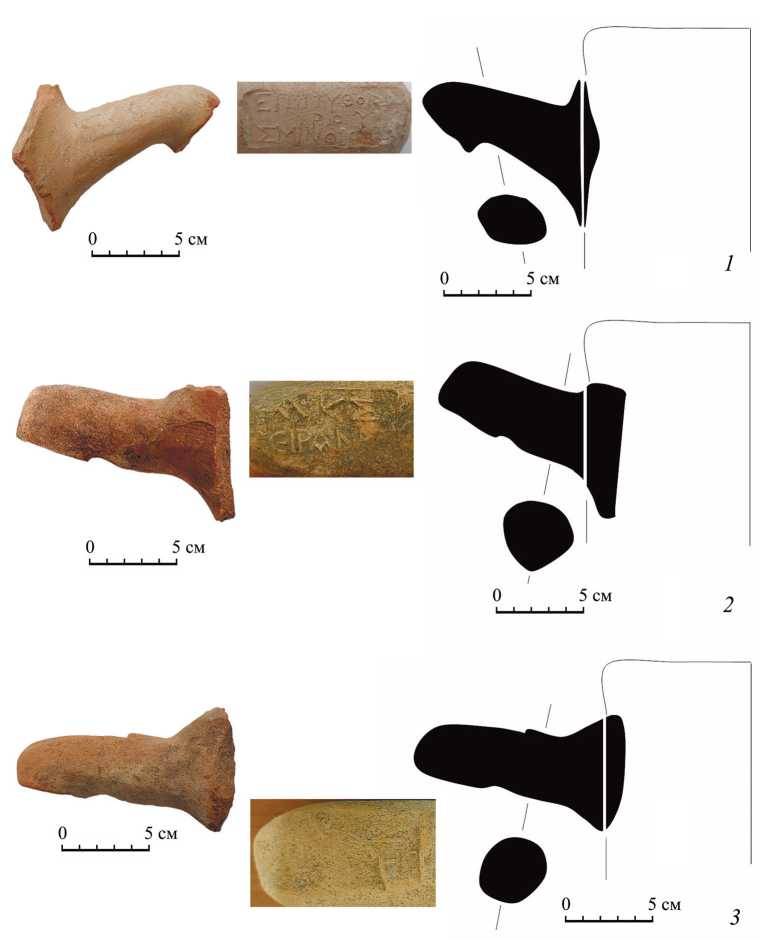
Fig. 3. Amisos. The stamped amphora handles 1–3 – Rhodos center
Rectangular, ? × ? cm, normal, two horizontal inscription lines, lunate sigma. Eponym: Ἀκεστίας. Fabricant: Εἰρηναῖος. Date: c. 85 – c. 40 BC. Matrix: RE-ΑΚΕΣΤΙΑΣ-RF-ΕΙΡΗΝΑΙΟΣ-.
[Ἐπ]ὶ Ἀκ(ε)σ- ? sic
[τία] Εἰρανα[ί]ης ? sic
It is not possible to fully analyse the names on the stamp due to the bad imprint. The form of the handle that bears this stamp is similar to those of Rhodian amphorae in the 1st century BC. Based on the period of the form of the handle, we believe that the names of the eponym Ἀκεστίας and the fabricant Εἰρηναῖος appear in the upper and lower lines, respectively. The both names are incorrectly formed.
The upper line of the stamp bears the letters alpha, kappa and sigma . When placed side by side, these letters suggest the name Ἀκεστίας, an eponym of Period VIIa (c. 85 – c. 40 BC). The Alexandria Benaki Collection contains stamps with the name of the eponym ( Cankardeş-Şenol , 2015. P. 158, 159). The lower line of the stamp bears the name Εἰρηναῖος. The fabricant Εἰρηναῖος is related to the eponyms Ἀρχίβιος (c. 115 BC), Ἑστίειος (c. 114 BC) and Ἀρατοφάνης II (c. 109 BC). The years of office of the eponyms reveal that the amphora fabricant Εἰρηναῖος was active between c. 115 and c. 109 BC ( Cankardeş-Şenol , 2017. P. 260).
If the association of the names of the eponym Ἀκεστίας and the fabricant Εἰρηναῖος on the stamp is accepted, a new relationship between them is revealed. This connection suggests that the fabricant’s period of activity may have been c. 115 – c. 85 – c. 40 BC. The RE-ΑΚΕΣΤΙΑΣ-RF-ΕΙΡΗΝΑΙΟΣ-001 stamps can be identified as a new mould.
No. 7 (Fig. 3: 3 ) . This stamp was recovered from the section called Room C of the 3-roomed area that emerged when Trenches IV, VI and VIII were merged in Grid A1. The fixed point for the surface level of the excavation area is +12.260 m. The level descent in the area where the handle was recovered ended at +9.180 m. The handle fragment was unearthed between these levels together with the remains of the area in question. Finds such as stroter, calypter, fragments of kitchen vessels, bronze nails, traces of plaster, unstamped amphora handles, and bronze coins belonging to the Mithradates VI Period were recovered from the area where the handle was found.
Rectangular, ? × ? cm, normal, two horizontal inscription lines, lunate sigma. Eponym: Ἀκεστίας. Fabricant: Εἰρηναῖος. Date: c. 85 – c. 40 BC. Matrix: RE-ΑΚΕΣΤΙΑΣ-RF-ΕΙΡΗΝΑΙΟΣ-001.
[Ἐπὶ] Ἀ(ε)κσ- ? sic
[τία Εἰραναί]ης ? sic
This stamp is from the same mould as stamp no. 6.
No. 8 (Fig. 4: 1 ) was recovered from the section called Room C of the 3-roo-med area that emerged when Trenches IV, VI and VIII were merged in Grid A1. The fixed point for the surface level of the excavation area is +12.260 m. The level descent in the area where the handle was recovered ended at +9.180 m. The handle fragment was unearthed between these levels together with the remains of the area
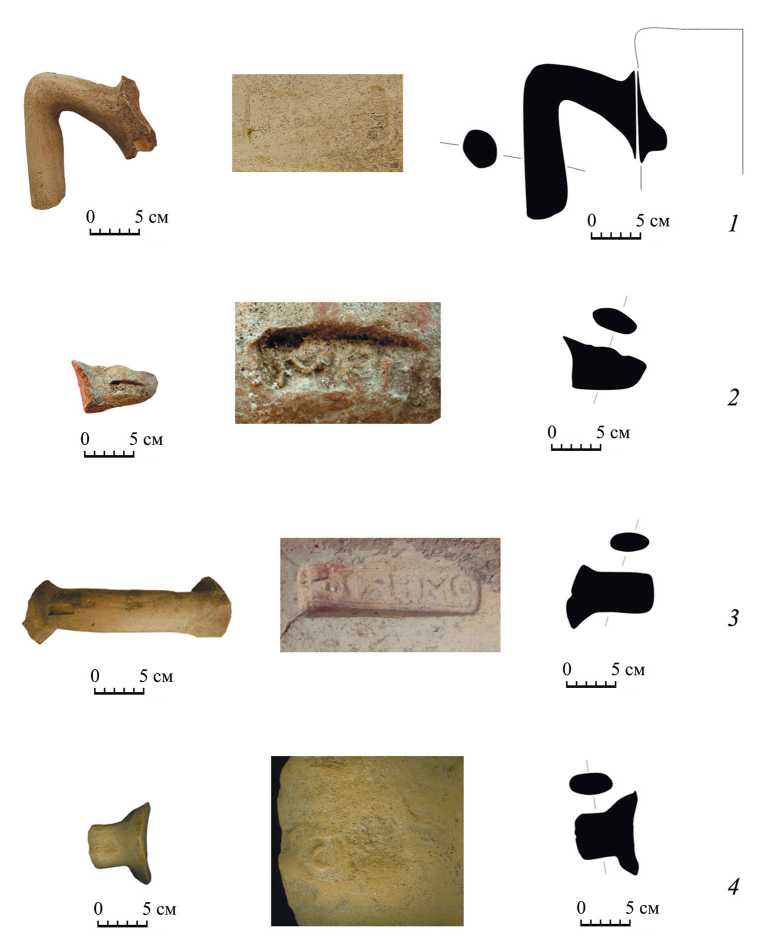
Fig. 4. Amisos. The stamped amphora handles
1 – Rhodos center; 2 – Chios center; 3 – Nikandros center; 4 – unidentified origin in question. Finds such as stroter, calypter, fragments of kitchen vessels, bronze nails, traces of plaster, unstamped amphora handles, and bronze coins belonging to the Mithradates VI Period were recovered from the area where the handle was found.
Rectangular, 4.2 × 1.6 cm, normal, one horizontal inscription line. Fabricant: Ἀγαθοκλῆς III. Date: MÖ c. 183 – c. 161 ВС. Matrix: RF-ΑΓΑΘΟΚΛΗΣ 03-.
Ἀγαθοκλεῦς
The stamp bears the name of the fabricant Ἀγαθοκλῆς III. The fabricant’s activity was under the magistracies of the eponyms Φιλόδαμος II (c. 183 BC), Κλεώνυμος II (c. 182 BC), Ἀγέμαχος (c. 181/179 – c. 176/c. 174 BC), Αἰνήτωρ (c. 178/176 BC), Σύμμαχος (c. 173/171 BC), Νικασαγόρας I (c. 172/170 BC), Ἀθανόδοτος (c. 170/168 BC), Ἀρατοφάνης I (c. 169/167 BC), Ἀρχιλαΐδας (c. 165/163 BC) and Ἀγέστρατος II (c. 161 BC). The magistracy years of these eponyms allow for dating the fabricant’s activity between c. 183 – c. 161 BC. Stamps bearing the name of this fabricant are found in Olbia (Леви, 1964. С. 267. № 164), Histria (Canarache, 1957. P. 255. No. 607), Tanais (Jöhrens, 2001. P. 408. No. 147–149), Sarayburnu-İstan-bul (Cankardeş-Şenol, Şenol, 1997. P. 51, 52. No. 1b), Pergamon (Börker, Burow, 1998. P. 41. No. 357–361. Taf. 14), Labruanda (Säflund, 1980. P. 13. No. 1), Kition (Calvet, 1982. P. 16. No. 13, 14), Salamis (Calvet, 1978. P. 223. No. 1), Paphos (Ni-colaou, 2005. P. 126. No. 299–302), Crocodilopolis-Arsinoe (Empereur, 1977. P. 6. No. 2, 3), Alexandria (Cankardeş-Şenol, 2000. P. 137. No. 1, 2; P. 392. No. 1; P. 471. No. 121; 2001. P. 402. No. 9), Varna Museum (Мирчев, 1958. С. 31. № 120), Marseille, National Museum of Athens, Benaki Collection in Alexandria and Graeco-Ro-man Museum in Alexandria affiche_LRF. php, RF-ΑΓΑΘΟΚΛΗΣ 03-27; 33-34; 38).
Chios Stamp
No. 9 (Fig. 4: 2 ) . This stamp was recovered from the section called Room A of the 3-roomed area that emerged when Trenches IV, VI and VIII were merged in Grid B2. The fixed point for the surface level of the excavation area is +12.260 m. The level descent in the area where the handle was recovered ended at +9.180 m. The handle fragment was unearthed between these levels together with the remains of the area in question. Finds such as stroter, calypter, traces of plaster and unstamped amphora handles were recovered from the area where the handle was found.
Rectangular, 3.1 × 1.2 cm, normal, abbreviation, one horizontal inscription line, lunate sigma. Fabricant: Μεν(. Date: Late 3rd – early 2nd century BC.
Μεν
The amphora stamp bears the abbreviation Μεν(. Chios amphora stamps bearing this abbreviation are found in Tenos ( Etienne , 1986. P. 54, 254. No. 249), Alexandria ( Alkaç , 2012. P. 374, 375, 388, 389. No. 248, 249, 275–277), Pergamon ( Börker, Burow , 1998. P. 60, 122, 123. No. 567, 568, 576–601), Carthage ( Jöhrens , 1999b. P. 256. No. 39. Taf. 25), Jerusalem ( Ariel , 1990. P. 75, S 455), Paphos ( Nicolaou , 2005.
P. 248. No. 734) and the National Museum of Athens2. The Μεν( stamp dates to the late 3rd – early 2nd century BC at Pergamon ( Börker, Burow , 1998. P. 60. No. 567–668. Abb. 1. Taf. 20) and to the early 2nd century BC at Tenos ( Etienne , 1986. P. 54, 254. No. 249). It is difficult to determine which Chios fabricant this abbreviation represents, as many stamps from Chios can complement this abbreviation ( Alkaç , 2012. P. 140). Some of the full or abbreviated names, monograms and symbols found on the stamps of the amphorae of Chios were also stamped on the handles of island-made lagynos. The abbreviation Μεν( is recorded as a stamp on both Chios amphorae and lagynos. This proves that the fabricant using the abbreviation Μεν( produced lagynos together with amphorae ( Alkaç , 2016. P. 92. No. 9).
Nikandros Stamp
No. 10 (Fig. 4: 3 ) . This stamp was recovered from the section where Grids A1 and B1 meet, in the section with a stone paved corridor and crepis to the south of the 3-roomed area that emerged when Trenches IV, VI and VIII were merged. The fixed point for the surface level of the excavation area is +12.260 m. The level descent in the area where the handle was recovered ended at +9.376 m. The handle fragment was unearthed between these levels together with the remains of the area in question. Finds such as stroter, calypter, traces of plaster, fragments of kitchen vessels, bronze nails, and unstamped amphora handles were recovered from the area where the handle was found.
Rectangular, 3.0 × 1.5 cm, normal, abbreviation, one horizontal inscription line. Fabricant: Φιλήμων. Date: 3rd–2nd century BC.
Φιλήμω(νος)
The stamp bears the abbreviation Φιλημω(. The inscription is placed in a rectangular frame. The nominative case of this stamp is Φιλήμων and the genitivus is Φιλήμωνος. The genitivus is abbreviated here. The form of the handle with the stamp is similar to the Nikandros Group amphorae3.
Unclassified Stamp
No. 11 (Fig. 4: 4). This stamp was unearthed in the area called botros in Trench III at the junction of Grids A3 and A4. The fixed point for the surface level of the excavation area is +12.260 m. The level descent in the area where the handle was recovered ended at +9.066 m. The handle fragment was unearthed between these levels at level +9.510 m. Imported black and red-figured ceramic sherds of Attic production, statuettes of Cybele sitting on the throne and statuettes of Kore, which were used as votive offerings to the goddess Cybele, were recovered below +9.510 m. crescent-shaped sigma. The inscription could not be deciphered because the left side of the stamp is broken.
Rectangular, ? × ? cm, normal, crescent-shaped sigma .
[….......]
[...]σ[...]
Conclusion
Eleven amphora stamps dated to the Hellenistic Period were found in the excavation at Çatalca-Karadoğan Mound, where the first foundations of Amisos were laid. These stamps are classified into Sinope (nos. 1–3), Rhodos (nos. 4–8), Chios (no. 9) and Nikandros (no. 10). The origin of one stamp could not be specified (no. 11).
A total of three Sinopean amphora stamps were found at Çatalca-Karadoğan Hö-yük. These stamps, dated between c. 257 – c. 190 BC, prove that Amisos maintained trade relations with Sinope, one of the cities of the region.
A total of five Rhodian amphora stamps were found at Çatalca-Karadoğan Höyük. These bear the names of Παυσανίας III (c. 152 BC), Πυθόδωρος (c. 150 – c. 147 BC) and Ἀκεστίας (c. 85 – c. 40 BC) as eponyms and Ἀγαθοκλῆς III (c. 183 – c. 161 BC) and Εἰρηναῖος (c. 85 – c. 40 BC) as fabricants. The names of the eponym Ἀκεστίας and the fabricant Εἰρηναῖος on the same stamp mould probably reveal a new relationship between the fabricant and eponym.
Amphora stamps of Rhodian origin were found in different parts of Amisos. They are generally dated between the end of the 3rd century BC and c. 137/136 – c. 85 – c. 40 BC. The historical concentration of these stamps is the 2nd century BC ( Alkaç et al. , in print; Şirin, Yiğitpaşa , 2023. P. 330, 331. Figs. 42–44). The stamps found in the mound, bearing the names of the eponym Ἀκεστίας and the fabricant Εἰρηναῖος, show that Rhodian wine was supplied to Amisos until c. 85 – c. 40 BC. Rhodos also established trade connections with Sinope, the western neighbouring city of Amisos. The earliest examples of Rhodian amphora stamps found in Sinope date to the end of the 4th century BC – first half of the 3rd century BC. As in Amisos, the historical concentration of Rhodian amphora stamps in Sinope is from the 2ndcentury BC, where the latest Rhodian examples are dated to Period VI (c. 107 – c. 88/86 BC) ( Conovici, Garlan , 2004. P. 106–119. No. 1–48).
The historical density and decline of Rhodian amphora stamps from Sinope and Amisos are parallel. The decline in the trade relations between Rhodos and Pon-tus from the early 1st century BC onwards could be explained by the conflict between the island and Mithridates VI. The amphora and wine-producing cities of the Hellenistic Period, especially Knidos, Rhodos and Chios, were negatively affected by the Roman – Mithridates VI wars.
This is evidenced by the historical data of Rhodian, Cnidian and Chios amphora stamps found in the Mediterranean and the Black Sea ( Alkaç , 2017). The two stamps from Amisos with the names of the eponym Ἀκεστίας and the fabricant Εἰρηναῖος are dated between c. 85 and c. 40 BC but do not allow us to comment on the trade activities of this period, since the total number of stamps from both cities between
c. 85 – c. 40 BC is very small. This information is an essential criterium for understanding the trade relations that Rhodos established with the Pontic cities.
A Chios amphora stamp was found at Çatalca-Karadoğan Höyük. According to Pergamon data, this dates to the late 3rd – early 2nd century BC and bears the abbreviation Μεν(. Among the amphora stamps found in the centre of Amisos and preserved in a private collection are examples of Chios origin (Ἀρχίδαμος, Ἀσκληπιάδης, Ἡγησίας and Παρ( ( Alkaç et al. , in print). These stamps provide important information about Chios’ trade relations with the Black Sea coastal cities of Anatolia. It has been revealed that Chios merchants also reached Sinope within the same region ( Gar-lan , 2007. P. 189. No. 61–65. Pl. I).
The amphorae identified in the literature as Nikandros Group were produced around Ephesos and Metropolis in Western Anatolia ( Cankardeş-Şenol , 2010. P. 126) and are generally dated to the 3rd and 2nd centuries BC ( Lawall , 2004. P. 177–188). An amphora stamp of this group was found at Çatalca-Karadoğan Höyük. This stamped amphora must also be, in general terms, dated to the samples within the group in question.
The Sinope, Rhodos, Chios and Nikandros amphora stamps found at Çatalca-Ka-radoğan Höyük must have been transferred here via Amisos. These are Hellenistic Period, epigraphic evidence of the mound structure. These stamps show the trade relations of Amisos rather than the mound settlement. Each amphora to be published from the borders of Amisos will be substantial evidence in understanding the trade connections of this city with the region in which it is located and with other regions.

